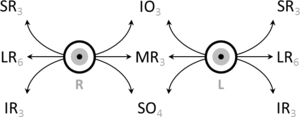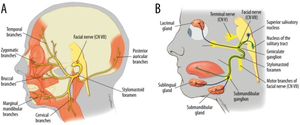We need you! Join our contributor community and become a WikEM editor through our open and transparent promotion process.
Cranial nerves
From WikEM
Cranial nerves
- CN I (Olfactory)
- Anosmia + perceived change in taste of food
- Deficit caused by shearing of the nerve ending passing through the cribriform plate usually by closed head trauma
- CN II (Optic)
- Monocular and binocular visual field defects
- Monocular: Giant cell arteritis, Anterior ischemic optic neuropathy, glaucoma, optic neuritis, trauma, increased ICP, emboli/arteritis/stenosis leading to retinal ischemia, ophthalmic artery or vein occlusion
- Binocular - Hemianopsia due to bilateral optic nerve disease.
- CN III (Oculomotor) –See Third Nerve Palsy
- CN IV (Trochlear)- See Trochlear nerve palsy
- CN VI (Abducens)- See Abducens nerve palsy
- Internuclear ophthalmoplegia - Lesion in medial longitudinal fasciculus, cannot adduct in horizontal lateral gaze, but normal convergence. Caused by multiple sclerosis or stroke
- CN V (Trigeminal)
- Jaw weakness and spasm. Jaw closure may be weak and/or asymmetric. +/- Trismus if irritative lesion to motor root.
- See trigeminal neuralgia
- CN VII (Facial)
- Upper motor neuron deficit – See Stroke, Hemorrhagic stroke, Multiple sclerosis, Amyotrophic Lateral Sclerosis (Upper and lower motor neuron disease)
- Sudden-onset of weakness: forehead sparing, facial droop
- Lower motor neuron deficit – See Bell's palsy
- Ipsilateral to defect: Inability to raise eyebrows, drooping of angle of mouth, incomplete closure of eyelid. No forehead sparing.
- Upper motor neuron deficit – See Stroke, Hemorrhagic stroke, Multiple sclerosis, Amyotrophic Lateral Sclerosis (Upper and lower motor neuron disease)
- CN VIII (Vestibular)
- Dysfunction may be characterized by: tinnitus, deafness, nausea, vertigo, balance issues
- See vertigo
- CN IX (Glossopharyngeal)
- Dysfunction may be characterized by: dysarthria, dysphagia
- CN X (Vagus)
- Dysfunction may be characterized by: hoarseness (unilateral vocal cord paralysis), dyspnea and inspiratory stridor (bilateral). Dysarthria, dysphagia.
- CN XI (Accessory)
- Dysfunction may be characterized by: Sternocleidomastoid and trapezius weakness leads to weak head rotation and shoulder shrug
- CN XII (Hypoglossal)
- Dysfunction may be characterized by: tongue deviation and wasting


